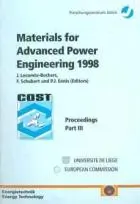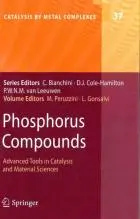
Materials for Advanced Power Engineering 1998 - Proceedings Part III

Report on Short-term Scientific Missions 1997-98

76 Eurosilva - Contribution to the Forest Tree Physiology

Innovative production technologies and increased wood products recycling and reuse - proceedings of the second international conference of COST Action FP1407
- Author(s): Kutnar, A., Schwarzkopf, M., Burnard, M., Sebera, V., Troppová, E.
- Publisher(s): Mendel University, Brno, Czech Republic
- Download PDF
- ISBN/ISSN: 978-80-7509-429-2 |
The second international conference organised by
focused on innovation and the environmental aspects of using wood and wood products, presenting state-of-the-art production technologies in wood modification, as well as the development of recycling technologies and systems for modified wood and related barriers and challenges.

Phosphorus Compounds: Advanced Tools in Catalysis and Material Sciences
- Author(s): M. Peruzzini and L. Gonsalvi (Eds)
- Publisher(s): Springer
- http://www.springer.com/series/5763
- ISBN/ISSN: 978-90-481-3816-6
Each chapter of Phosphorus Compounds: Advanced Tools in Catalysis and Material Sciences has been carefully selected by the editors in order to represent a state-of-the-art overview of how phosphorus chemistry can provide solutions in various fields of applications.
The editors have assembled an international array of world-renowned scientists and each chapter is written by experts in the fields of synthetic chemistry, homogeneous catalysis, dendrimers, theoretical calculations, materials science, and medicinal chemistry with a special focus on the chemistry of phosphorus compounds.
This book series covers topics of interest to a wide range of academic and industrial chemists, and biochemists. Catalysis by metal complexes plays a prominent role in many processes. Developments in analytical and synthetic techniques and instrumentation, particularly over the last 30 years, have resulted in an increasingly sophisticated understanding of catalytic processes.
Industrial applications include the production of petrochemicals, fine chemicals and pharmaceuticals (particularly through asymmetric catalysis), hydrometallurgy, and waste-treatment processes. Many life processes are based on metallo-enzyme systems that catalyze redox and acid-base reactions.
Catalysis by metal complexes is an exciting, fast developing and challenging interdisciplinary topic which spans and embraces the three areas of catalysis: heterogeneous, homogeneous, and metallo-enzyme.
Catalysis by Metal Complexes deals with all aspects of catalysis which involve metal complexes and seeks to publish authoritative, state-of-the-art volumes which serve to document the progress being made in this interdisciplinary area of science.
Phosphorus Compounds: Advanced Tools in Catalysis and Material Sciences is of interest to a general leadership ranging from advanced university course students to experts in academia and chemistry.

Chembiogenesis 2005 - Book of Abstracts
- Pages: 65 pages
- Publisher(s): Malte Reimold
Abstracts of the Chemo-biogenesis 2005, which took place in Venice, Italy on September 28 – October 1.

Strategies for a Low Carbon Urban Built Environment
- Author(s): Vincent Buhagiar (Ed)
- ISBN/ISSN: 978-99932-7-293-9
This publication is the outcome from the mid-term conference held in Munich on 24 – 25 September 2008.

Interplay between Usability Evaluation and Software Development
- Pages: 81
- Author(s): S. Abrahão, E. Lai-Chong Law, J. Stage, K. Hornbæk, N. Juristo
- Publisher(s): Audio Visual Services, University of Leicester
- Download from external website
Proceedings of the workshop held on 24 September 2008 in Pisa, Italy.

Brain Damage and Repair: From Molecular Research to Clinical Therapy
- Pages: 721 pages
- Author(s): T. Herdegen, J. Delgado-Garcia
- Publisher(s): Kluwer Academic Publishers
- ISBN/ISSN: 978-1-4020-1892-3
Brain Damage and Repair aims to attract the interest of neuroscientists and clinical neurologists by building a novel bridge from molecular research to clinical therapy. This novel approach reveals the functional features of neurons and glia un the particular context of vulnerability and self-protection, intracellular properties and extracellular matrix. Arising from this platform, this volume unfolds the molecular and systemic processes underlying migration disorders, axonal injury, repair and regeneration. Comprehensive chapters on neurological diseases, such as M. Alzheimer, M. Parkinson, ALS, stroke or trauma, take this knowledge; apply it at clinical level to provide a basis for novel therapeutic strategies. Brain Damage and Repair is completed with chapters on imaging techniques, viral gene transfer or legal international handling of stem cell transfer and patents of DNA/proteins.
